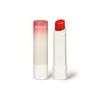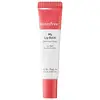Hanyul Lip Balm Versus innisfree My Lip Balm
What's inside
What's inside
 Key Ingredients
Key Ingredients

 Benefits
Benefits

 Concerns
Concerns

 Ingredients Side-by-side
Ingredients Side-by-side

Caprylic/Capric Triglyceride
MaskingPhytosteryl Isostearyl Dimer Dilinoleate
EmollientSimmondsia Chinensis Seed Oil
EmollientDiisostearyl Malate
EmollientHydrogenated Polyisobutene
EmollientBis-Diglyceryl Polyacyladipate-2
EmollientHydrogenated Castor Oil Dimer Dilinoleate
Skin ConditioningBeeswax
Emulsion StabilisingSynthetic Wax
AbrasiveMicrocrystalline Wax
Emulsion StabilisingPolyethylene
AbrasiveCocos Nucifera Seed Butter
Skin ConditioningTocopheryl Acetate
AntioxidantCandelilla Wax Esters
Parfum
MaskingPolyglyceryl-2 Triisostearate
EmulsifyingCopernicia Cerifera Wax
CI 17200
Cosmetic ColorantCI 77891
Cosmetic ColorantPolyglyceryl-2 Diisostearate
EmulsifyingWater
Skin ConditioningCI 77491
Cosmetic ColorantButylene Glycol
HumectantPropanediol
Solvent1,2-Hexanediol
Skin ConditioningBHT
AntioxidantNatto Gum
Glycine Soja Seed Extract
Skin ConditioningEthylhexylglycerin
Skin ConditioningDisodium EDTA
Caprylic/Capric Triglyceride, Phytosteryl Isostearyl Dimer Dilinoleate, Simmondsia Chinensis Seed Oil, Diisostearyl Malate, Hydrogenated Polyisobutene, Bis-Diglyceryl Polyacyladipate-2, Hydrogenated Castor Oil Dimer Dilinoleate, Beeswax, Synthetic Wax, Microcrystalline Wax, Polyethylene, Cocos Nucifera Seed Butter, Tocopheryl Acetate, Candelilla Wax Esters, Parfum, Polyglyceryl-2 Triisostearate, Copernicia Cerifera Wax, CI 17200, CI 77891, Polyglyceryl-2 Diisostearate, Water, CI 77491, Butylene Glycol, Propanediol, 1,2-Hexanediol, BHT, Natto Gum, Glycine Soja Seed Extract, Ethylhexylglycerin, Disodium EDTA
Petrolatum
EmollientHydrogenated Castor Oil Dimer Dilinoleate
Skin ConditioningMicrocrystalline Wax
Emulsion StabilisingBeeswax
Emulsion StabilisingSimmondsia Chinensis Seed Oil
EmollientHelianthus Annuus Seed Oil
EmollientTheobroma Grandiflorum Seed Butter
Skin ConditioningSilica Silylate
EmollientCitrus Aurantium Bergamia Fruit Oil
MaskingCaprylic/Capric Triglyceride
MaskingIsostearic Acid
CleansingDimer Dilinoleyl Dimer Dilinoleate
EmollientDiisostearyl Malate
EmollientTocopheryl Acetate
AntioxidantDehydroacetic Acid
PreservativeCI 77491
Cosmetic ColorantCI 45410
Cosmetic ColorantCitric Acid
BufferingCI 77891
Cosmetic ColorantMentha Piperita Oil
MaskingCI 15985
Cosmetic ColorantSodium Saccharin
MaskingCI 15850
Cosmetic ColorantCI 77492
Cosmetic ColorantTocopherol
AntioxidantWater
Skin ConditioningGlycerin
HumectantButylene Glycol
HumectantCamellia Sinensis Leaf Extract
AntimicrobialCitrus Unshiu Peel Extract
MaskingOpuntia Coccinellifera Fruit Extract
Skin ConditioningOrchid Extract
Skin ConditioningCamellia Japonica Leaf Extract
Skin ConditioningCitrus Sudachi Fruit Extract
Humectant1,2-Hexanediol
Skin ConditioningPetrolatum, Hydrogenated Castor Oil Dimer Dilinoleate, Microcrystalline Wax, Beeswax, Simmondsia Chinensis Seed Oil, Helianthus Annuus Seed Oil, Theobroma Grandiflorum Seed Butter, Silica Silylate, Citrus Aurantium Bergamia Fruit Oil, Caprylic/Capric Triglyceride, Isostearic Acid, Dimer Dilinoleyl Dimer Dilinoleate, Diisostearyl Malate, Tocopheryl Acetate, Dehydroacetic Acid, CI 77491, CI 45410, Citric Acid, CI 77891, Mentha Piperita Oil, CI 15985, Sodium Saccharin, CI 15850, CI 77492, Tocopherol, Water, Glycerin, Butylene Glycol, Camellia Sinensis Leaf Extract, Citrus Unshiu Peel Extract, Opuntia Coccinellifera Fruit Extract, Orchid Extract, Camellia Japonica Leaf Extract, Citrus Sudachi Fruit Extract, 1,2-Hexanediol
Ingredients Explained
These ingredients are found in both products.
Ingredients higher up in an ingredient list are typically present in a larger amount.
1,2-Hexanediol is a synthetic liquid and another multi-functional powerhouse.
It is a:
- Humectant, drawing moisture into the skin
- Emollient, helping to soften skin
- Solvent, dispersing and stabilizing formulas
- Preservative booster, enhancing the antimicrobial activity of other preservatives
Beeswax is natural wax produced by honey bees and can be synthetically created. It consists mainly of fatty acid esters and long-chain alcohols.
In cosmetics, beeswax is a emollient. Due to its waxy structure, it creates a protective barrier. This barrier prevents water from evaporating off the skin.
This may not be a good ingredient for oily skin. We recommend speaking with a professional if you have concerns.
Beeswax cannot be removed with water, but can be taken off with an oil cleanser.
Beeswax is also antiseptic and contains vitamin A.
Learn more about BeeswaxButylene Glycol (or BG) is used within cosmetic products for a few different reasons:
Overall, Butylene Glycol is a safe and well-rounded ingredient that works well with other ingredients.
Though this ingredient works well with most skin types, some people with sensitive skin may experience a reaction such as allergic rashes, closed comedones, or itchiness.
Learn more about Butylene GlycolThis ingredient is an emollient, solvent, and texture enhancer. It is considered a skin-softener by helping the skin prevent moisture loss.
It helps thicken a product's formula and makes it easier to spread by dissolving clumping compounds.
Caprylic Triglyceride is made by combining glycerin with coconut oil, forming a clear liquid.
While there is an assumption Caprylic Triglyceride can clog pores due to it being derived from coconut oil, there is no research supporting this.
Learn more about Caprylic/Capric TriglycerideCi 77491 is also hydrated iron III oxide. It's sole purpose is to give a red/pink hue to products.
Iron III oxides are classified as inorganic chemicals for coloring.
Synthetically created Ci 77491 is considered safer than those naturally found. This is because the synthetically created version may contain less impurities. Iron oxides are generally non-toxic and non-allergenic.
Learn more about CI 77491Ci 77891 is a white pigment from Titanium dioxide. It is naturally found in minerals such as rutile and ilmenite.
It's main function is to add a white color to cosmetics. It can also be mixed with other colors to create different shades.
Ci 77891 is commonly found in sunscreens due to its ability to block UV rays.
Learn more about CI 77891Diisostearyl Malate is an emollient and most often used in lip products. It comes from isostearyl alcohol, a fatty acid, and malic acid, an AHA.
As an emollient, Diisostearyl Malate helps create a thin film on your skin to trap moisture in. This helps keep your skin soft and smooth.
Hydrogenated Castor Oil Dimer Dilinoleate is an oil and isn't fungal acne safe.
Microcrystalline Wax is created by de-oiling petroleum. It is highly refined and purified before being added to cosmetics.
Microcrystalline Wax is used to enhance the texture and create even consistency. It helps stabilize a product by preventing ingredients from separating.
This oil comes from the seeds of the desert shrub called Jojoba. It is more commonly known as jojoba oil, a non-comedogenic oil.
Jojoba oil does not contain fragrance and has many fatty-acids, making it a great soothing ingredient.
It also contains Vitamin E, a great moisturizing ingredient. Vitamin E is also an antioxidant and protects your skin against oxidative damage.
This ingredient humectant properties, meaning it helps draw moisture from the air. This helps keep your skin hydrated.
While jojoba has antibacterial properties, it is only able to kill some strains of bacteria.
Studies also show it helps in wound healing. In fact, Indigenous cultures have used jojoba as a moisturizer and to help treat burns for centuries.
Fun fact: Jojoba oil similar to natural human skin sebum, so it has a great effect on dry skin. It is also promising with helping to regulate sebum production.
Due to its fatty acid content, Jojoba oil may not be fungal acne safe. We recommend speaking with a professional if you have any concerns.
Learn more about Simmondsia Chinensis Seed OilTocopheryl Acetate is AKA Vitamin E. It is an antioxidant and protects your skin from free radicals. Free radicals damage the skin by breaking down collagen.
One study found using Tocopheryl Acetate with Vitamin C decreased the number of sunburned cells.
Tocopheryl Acetate is commonly found in both skincare and dietary supplements.
Learn more about Tocopheryl AcetateWater. It's the most common cosmetic ingredient of all. You'll usually see it at the top of ingredient lists, meaning that it makes up the largest part of the product.
So why is it so popular? Water most often acts as a solvent - this means that it helps dissolve other ingredients into the formulation.
You'll also recognize water as that liquid we all need to stay alive. If you see this, drink a glass of water. Stay hydrated!
Learn more about Water